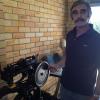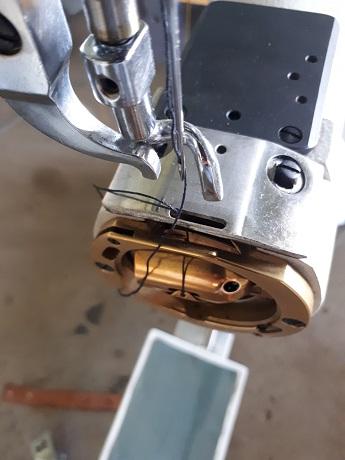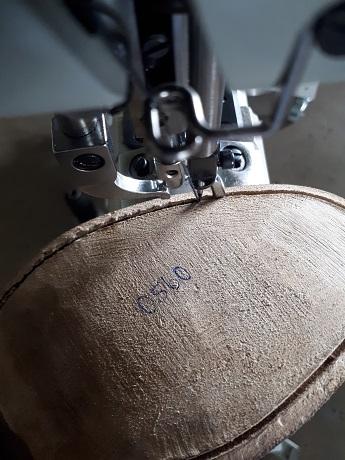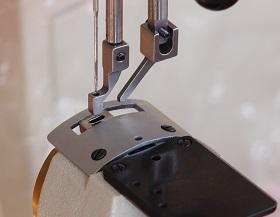-
Content Count
518 -
Joined
-
Last visited
Posts posted by Singermania
-
-
HI, some time ago I put on a post about sewing shoe soles on the Cowboy CB4500 with the narrow foot set, many people asked to see it in action and I really dropped the ball and didn't do much about it because of other commitments and just plain laziness. We just happen to be Australia's Cowboy dealers however this can be done equally as well on a Cobra or Highlead and so on. There are a couple of narrow feet sets available for these machines, but this set seems to give the best access along with a modified narrow slotted plate.....I had over 50 years of sewing but very little to do with shoes, really only repaired a few pairs of sandals, so to do this job meant standing at the end of the machine and pushing the boot against the modified plate, very much against my usual method of just holding the leather straight and not exerting any pressure!! With this foot set the inner foot sits in front of the outer foot and the needle, the other foot set (last foto) the inner foot is as per norm and has a hole for the needle.
-
4 hours ago, Yankee63 said:Why would you give a "junk" machine to those who bought high dollar machine? Sounds like you would be shooting yourself in the foot for future sales.
Nobody is trying to lose sales for you by not buying a high dollar machine when basic stitching is all you need for leather.
Were the china machines so crappy when you supposedly "gave" them away? Did you tell your customers they were basically just junk ?
It don't make sense.
Doug
Doug I don't think of them as junk, for the money they are exceptional. I was pointing out that patchers (in general) are designed for repair work, not quality sewing, if you produce a good quality stitch then that's great.....I am not embarrassed to own one. We don't sell a patcher as the patchers from our own supplier didn't pass our scrutiny... so there is no clash with out own product.
-
2 hours ago, mikesc said:Agree 100% with Wiz..the only one who has used the word junk is Yankee63..
Singermania probably has the largest collection of machines ( I remember the many pictures, of many many machines all lined up like the sewing machine equivalent of the Terracotta army of any dealer..anywhere..and his advice is extremely well respected by all of us..A lot of businesses ( mine included ) give stuff away to people who spend a lot of money with us..Doesn't mean it is junk that we give away, just means that "whatever" didn't cost us so much to begin with in either time or money..so we throw in a little extra ( could be needles, thread, machine, tools for some of the dealers, for others of us it could be an item or items that we normally make / sell ) ..Quit trying to pick a fight with him..or anyone for that matter..
of any dealer..anywhere..and his advice is extremely well respected by all of us..A lot of businesses ( mine included ) give stuff away to people who spend a lot of money with us..Doesn't mean it is junk that we give away, just means that "whatever" didn't cost us so much to begin with in either time or money..so we throw in a little extra ( could be needles, thread, machine, tools for some of the dealers, for others of us it could be an item or items that we normally make / sell ) ..Quit trying to pick a fight with him..or anyone for that matter..
Thanks Mikesc, yes I still have the machines. I might have sounded harsh re the patchers, it wasn't my intention. They do in fact punch above their weight. Of the three I have, one is set up on a block of heavy timber and I do use it from time to time, its fine. The machines are relatively trouble free from my experience. When we sell machines some people have machines already and can sew, some others are newbies and often they will buy the simplest machine they can, so often that is a handcrank of some kind. The reality is that handcranks are not really easier as you are cranking, feeding the material and your eye can move a bit too. So a greater proportion of people buying the little patchers are going to be first time machine owners and there is going to be a greater learning curve...… ie its expected then that these people will experience more problems. To put it another way, I get a lot more phone calls for assistance from people that have not sewn before than those that have on any machine I sell.
-
2 hours ago, Hockeymender said:Just remember what they say about opinions...........
Are you talking to me? I don't recall saying the machines were junk. They are cheap but do in fact sew quite well. We run Australia's biggest and most successful heavy leather machine company so we did not shoot ourselves or anyone else in the foot. Sometimes when you buy some Kellogs Corn Flakes you get a cheap plastic animal, does that make the corn flakes rubbish?
-
13 minutes ago, mikesc said:
I enjoyed / appreciated Darren's contributions here, I hope that his situation improves, and that he will be back...Darren and I are friends, though he is not answering communication at present. He admitted himself that he messed up pretty badly and we and others have been trying to help those that did not receive machines, did not get machines that worked, did not get machines back that were in for service, did not get their full orders and so on. I'm guessing you will not see him here or anywhere else until the creditors disappear. It is an awkward situation, a lot of accusations and threats have been made. As a veteran of many years in business and a couple of recessions I know it can happen to anyone.
With regards the Chinese Patcher, I did not mean to make anyone feel insecure about owning one (I have 3), I was intending only to point out they are designed for repair work, not quality leather work. They do punch above their weight, a reasonable stitch can be had, though the needle will only take quite thin thread. Darren emailed me a manual a while back as we were giving the patchers away with more expensive machines and I wanted to compare his manual with what I had written for ours, however I have searched and so far cant find it.
-
7 hours ago, vpd66 said:Do you own one or have you ever sewn with one? They actually sew really well and I consider them an excellent low dollar home hobby machine for someone that doesn't want to spend 4 figures on a sewing machine.
As I said above, I have three of them and yes have sewn on them, we used to give them away with our more expensive machines. Also as I have said in the past, they surprisingly do sew quite well, though not thru very thick leather which is in excess of half an inch.
,
-
A point on these machines, remember they are called 'shoe patchers', not 'quality leather goods sewers'....so they are designed to repair footwear either by entering the shoe and resewing broken stitches or by sewing on new elastic sides to boots. To spend hours researching these machines is really not going to be productive. If you want to make nice leather goods then you will either be disappointed with this machine or you are a very patient and talented sewer. Darren sold them at horse events for people wanting to repair summer rugs, he screwed them to a lump of wood and cleaned them up a bit..... it didn't end all that well.
-
Most of the machines from that era were similar, ie the Claes, Bradbury, Elastic etc etc.....I have Claes, Durkoepp, Adler, Singer, Elastic, Bradbury and yes even three of these little Chinese guys in my collection. None of the new Chinese machines required any rotation, if you were to be fussy a bit of sandpaper over the rough edges might be in order. What do you mean by 'three methods to install the carrier and shuttle'? This machine has a little bobbin that sits inside a bobbin case, the thread gets tensioned by the case and comes out to get picked up by the point of the hook. If you are not picking up the thread then the needle is at the incorrect height or the timing has been knocked out by a tooth.
-
Darren is presently and for the foreseeable future 'gone to ground'. I thought I had a manual for the machine you mention, however cannot find it. The unit though is so incredibly simple that I wonder what a manual might help with. As with all machines you need to match the needle size to the thread size and adjust the tensions. Remember patchers only have drive from the foot, the foot is toothed and pulls the material thru, there is no feed dog, so feed is basic and easily upset if you push or pull or allow the material to hang over the arm and add weight. If you really need help any old patcher manual will help you, for example the Able 290 is similar to the old Claes Elastik type patchers.
-
I think one small advantage of the handcrank on the end flywheel is that you are cranking in the same plane, wheras with front wheels the rotation is not the same direction as the sewing.
-
Hand cranking standard end flywheel machines like the 2500 and 3200 is fine and we do both here at Cowboy Leather Machines in Australia, it only takes a minute or two to get used to the motion. However as you say it will really only work on short bed machines, you cant really hand crank a cowboy CB4500.
-
We commonly fit hand crank handles to the Cowboy CB2500 and CB3200, additionally there is now the Cowboy Outlaw. In older machines some 29k had them, older Durkopp and of course the Pearson no 6 and Landis no 1.
I thought we'd had just about every 45K model thru our workshop and showroom, but never one with a front mounted handwheel !!
-
the old Singer manual test was holding the thread taut at 45 degrees and seeing if the needle slid down it, or I find if the thread is difficult to shove thru the eye of the needle then you need a bigger needle, or if it slops about then a smaller needle. In the end the machine will sew badly with the wrong needle.
-
49 minutes ago, Matt S said:I managed to get hold of a pack of Schmetz 160s a couple years ago. Even with a no.4 needle steady I got a lot of breakages, which was painful at about £2/needle. There was a 3-1/2 size needle, which is pretty much a 180 -- I have some old IVIs which came with the machine. AFAIK there's no current production for the 331 needle class -- we're still using up the last batch of however many millions Schmetz was convinced to make.
The manual suggests using a size 3 needle (nm160) with 18/3 linen for sewing around winkers/blinkers @ 10SPI. Is that a common size thread for that sort of job, or was this one of those weird late Victorian show/dress/fancy harness things?
25 minutes ago, CowboyBob said:The last time I talked with Schmetz they wanted an order of 10,000.
Sad to hear of your needle breakages, don't forget when you change needle size to adjust the needle follower under the needle plate, correctly adjusted its a whisker from the needle and stops it bending backwards under load, this will reduce needle breakage and also dropped stitches when heavy materials pull across the arm.
-
We bought the last 180 from Schmetz quite some time back and are all gone, I'm told to get a new run manufactured you need to order many thousands. Using pre waxed thread in any sewing machine is not the best of ideas... the Pearson along with many other machines has a was box/tank, however it was intended for use with heated liquid wax.
-
Yes mate agree with you, we at Cowboy Leather Machines in Australia sell the Cowboy CB4500 for saddlery work, we supply it with the double toe foot, left and right feet, left and right dogleg feet, roller guide, standard plate, narrow slotted plate, holster and stirrup plates for pretty much the reasons you outline, the machine is great but better with all the bits. Pearsons commonly came with a double toe foot, left and right feet, pricker feet to drop stitches into in varying sizes, needle steadies in varying sizes, roller guides, rein rounder attachments and attachments to do piping and flat bed table. I've sold most of the needle steadies and pricker feet now to people wanting to option up their Pearsons, here is a foto of some of my machines. With regards to Pearsons being old and not sewing consistant stitching, I haven't found this to be the case, the head is fitted with vertical and horizontal fully adjustable sections that can be moved in to take up slack.
-
6 hours ago, catskin said:I wonder if some of those that don't have the various attachments ( I have nearly all of them )for the 441 type of machine don't realize that they are available. Like the saddle maker that was here last winter , he has a genuine Juki 441 ( had it for many years ) but only had the big feet was very surprised that these other feet feed dogs and plates were available. And intended to order them. So like the Pearson if you do not have the right attachments it limits what you can do. I do not know what attachments are for the Pearson or where it might be possible to get any of them. I got only the machine. I made an edge guide and bobbin winder. As my Pearson is ,doing any fine work would be difficult. My Cowboy does that easy. For example sewing 2 stitch lines on 1/2 " wide leather with 207 thread. I would be very happy if those of you that have Pearson attachments would post pictures. I might be able to make my own version of some. As others likely could too.
Hi, there do exist a few attachment for the no 6, most common are left and right roller guides, needle steadies and bobbin winders. Here is a photo of the rein rounder attachment that we were remanufacturing a while back, this is the original....

-
Great to see so much intelligent comment on the older machines, I cant say for sure that the no 6 is better than the Landis no 1, only that the former is needle feed and the latter is walking foot. Needles currently available for the no 6 are as far as I know 160, 200, 230, 250. I also have considerable stock of roundpoint in 300. I've included a photo of some of my Pearsons.
-
-
Again I have a number of original Pearson no 6 clutches here, however they are heavy and probably too expensive to ship. A lot of people think the no 6 was never motorised but they were.
-
Yes mate, Henry Veenhoven is a great guy, he'll help. A clutch motor will most likely be a bit quick for a Pearson, a 750watt servo running thru a speed reducer is the best way.... I think.
-
If you need any help with your no 6 let me know, I might be able to help, bobbins winders are hard to find apart from a machine, though we did sell 3 recently, none at the moment. Treadles are also hard to find on there own. I have a flywheel, but the cost of shipping it to the us is not going to be reasonable.
-
I also love old machines, however a machine is a machine is a machine, the life in it is the life you see in it with your own eyes. If you see it then good, if you don't then that machine will suit someone else.
-
Hi Jordan, I'm in Australia so not quite what you requested and am also a sewing machine dealer, we have a few of these Outlaw here in stock and one set up as a demo machine, its had a few goings over by locals and works really quite well, no obvious faults at all. My only comment is that I'm used to very smooth running machines and find that the back and forth motion is a bit clunky to what I'm used to, however if I was going to shows and doing on the spot repairs I'd be happy to take it with me.








Sewing shoes soles
in Leatherwork Conversation
Posted · Report reply
HI, no didn't seem to cause any marks, I pushed pretty hard at times especially at the toe and book came out unscathed.